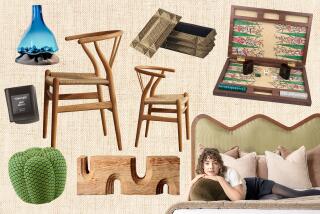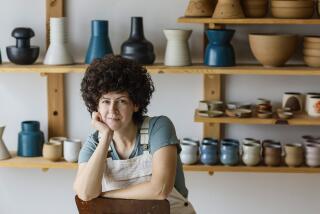A Perfect Setting : That Vernonware--it’s turning up everywhere, from movies to estate sales. And for many fans, collecting it runs in the family.
So I finally joined modern society and at last was sitting in a movie theater watching “that movie,” ready to float away to a watery world of adolescent romance, icebergs and tragedy. Then I saw the dishes. It was a fleeting sight, gone faster than you could say, “It’s an iceberg, stupid!”
My husband got the requisite elbow poke. Yes, he had seem them. Yes, it is amazing where they show up. Now watch the movie. I did, but with the satisfaction of a bird-watcher who has just glimpsed something special. After all, we had just had another Vernonware sighting. In my family, that’s an event.
Let me explain. In the 1940s and early 1950s, my father and uncle worked for Vernon Kilns, a pottery company in the industrial town of Vernon that made a huge variety of California-style pottery from 1931 to 1958. Along with fine-art pottery, figurines and specialty items, it cranked out mountains of dinnerware.
Those dishes were called Vernonware and filled the postwar cupboards of many a suburban home, particularly in the West, where they were heavily marketed. Naturally, Vernonware was the mainstay in our house, especially one of the most popular patterns, a hand-painted brown and yellow plaid design called Organdie.
And what were the dishes Rose’s granddaughter used early in “Titanic” as she fixed up a little tea for her now-aged grandmother, who (oh, irony!) was working at a potter’s wheel? If you answered Organdie, go straight to the front of the lifeboat line.
Today Vernonware is found in antique stores, at estate sales and, if you’re lucky, at the occasional garage sale of someone who got stuck with Grandma’s things and doesn’t know diddly about dishes. It’s not as widely recognized as Bauer and Fiesta pottery from the same era, and you won’t see reproductions of it in those retro-diners serving up nouveau meatloaf.
It’s usually less expensive than other old pottery too. You can get Vernonware dinner plates for $5 and the more common casserole dishes and platters for $35 to $45.
No matter. Vernonware collectors are loyal, forever smitten by its artistry, sunny Western colors, French-country influence, hand-painted designs and romantic old California look.
“I think it’s a lot more unique [than other period pottery]. I just see Vernon as something a little more interesting, a little more varied,” says collector Judi Thompson of Anaheim. “It was really, really ahead of its time.”
Thompson credits the company’s artists for that. The company employed many popular artists of the time, most notably Don Blanding, known for his romantic Hawaiian art and writing, and Rockwell Kent, an artist of the social realist school known for everything from his public-works murals to an illustrated edition of “Moby Dick.”
These artists and others created unique fine pottery, from Art Deco vases to animated figurines commemorating a strange new movie called “Fantasia.” The Holy Grail of Vernonware is anything from the Salamina series, a striking dinnerware design created by Kent that was adapted from his best-selling book by the same name.
Salamina was Kent’s housekeeper in Greenland, where he went to paint for a time. Apparently she was pretty darn inspiring. They are lovely pieces, the ones you’ll usually see behind the glass at antique stores.
*
Still, artists’ touches trickled down to the workaday dinner dishes of the middle class too, Thompson says.
You’ll see it in the glazes, which ranged from the shiny, wet-looking high gloss on Organdie and others to the satin-matte finishes used on several other designs.
The colors, shapes and patterns of the dinnerware bore the artists’ touches too. They ranged from warm Southwestern floral and geometric designs in earth tones to cool azure blues and plain orchid pastels.
A 1938 advertisement in Sunset magazine calls a Vernon Gift Package “45 pieces of California color.” Several patterns celebrated romantic notions of old California with quaint scenes of cowboy, pueblo and mission life.
Like the scenes it often depicted, Vernonware’s era couldn’t last. Competition from inexpensive postwar imports forced the company to close in 1958.
A wistful memory of that era hooked Thompson into collecting Vernonware 15 years ago. She was browsing through an antique store when she came across an Organdie casserole.
The sight threw her back to her early childhood in Monterey Park, to a cozy meatloaf-and-mashed-potatoes kitchen outfitted with a set of Organdie dishes presented to her mother by her father. Thompson even had a 1949 photo of herself and her father baking a batch of gingerbread men with a Vernonware mixing bowl in the background.
“My father died early in my life, and I just stood there in that antique store and cried. And I bought the thing. And it’s gone crazy from there,” Thompson says.
Indeed. Thompson has 18 Organdie place settings, including everything from coasters to demitasse cups, along with an assortment of serving pieces, egg cups, custard dishes and spoon holders.
Her collection also includes many of Vernonware’s fine art pieces.
*
Maxine Feek Nelson, who uses Vernonware for her everyday dishes in her home in Scottsdale, Ariz., was lured by nostalgia for 1946, when the war was finally over and she was a bride setting up a first home in Southern California. Her family’s wedding gift was a starter set of Brown Eyed Susan, another popular Vernonware design, decorated with--what else?--those sunny little flowers.
Years later in the 1960s, her starter set had been long since packed away when she noticed pieces of Susan showing up at flea markets. Then it began. Her collection grew to include a variety of Vernonware and sparked a book, “Collectible Vernon Kilns” (Collector Books, 1994).
“It has a lot more character [than Bauer and Fiesta],” Nelson says. “I probably shouldn’t say that, because I know the people who are into the Arts and Craft movement really like the look of Bauer and Fiesta. But Vernon was really more known for its famous artists.”
Take that, Bauer fans.
Besides, Vernonware addicts have the fun of those rare but still-out-there Vernon sightings. Set designers seemingly love it. Maybe it’s Vernonware’s ability to lend homeyness to a scene without overpowering the product or dramatic moment.
Organdie has cozied up to a box of herb tea in one of those Sunday coupon fliers. In the television series “Northern Exposure,” a Vernonware pattern called Homespun graced Maggie’s dining table. In the same show, the Brig tavern served soup in Brown Eyed Susan bowls. And then the ultimate sighting, that brief moment in “Titanic.”
In my family, this dinnerware folklore is the stuff of legend. There’s the story of how my father, a journeyman jiggerman at the pottery, showed up at my mother’s bedroom window with a box of Brown Eyed Susan for her to stow in her hope chest. Who needs flowers and ballads when you’ve got swell dishes?
Then there’s the driveway tale. While tile setter Simon Rodia was building his famous Watts Towers with shards of tile, my dad was smashing up flawed pieces of Vernonware, rejected at the pottery, to cover the dusty dirt driveway of my parents’ first home in what was then the rural town of Downey. He carted it home in his ’36 Ford sedan, flung it, smashed it and stomped it into a lovely bisque-colored gravel.
Check three generations of family albums and you’ll see a recurring sight--family pets photographed in the world’s biggest teacup (Organdie pattern, of course). The cup was actually a punch or salad bowl Vernon called the “Colossal cup and saucer.”
*
My grandparents thought this eccentric tradition was quite a hoot. For many years it was a photo of their dachshund in the great cup that sat atop that suburban postwar place of family honor, the console television set that was as big as a Buick.
I’m sure there are more Hollywood Vernonware sightings out there waiting to float by my dinnerware radar screen. I’m just lucky that way. Maybe even chosen, you might say, like those people who say they’ve been contacted by Elvis.
Recently I was watching a video of “Honey, I Shrunk the Kids” with my own kids when I popped up out of my seat. There, in the closing scene, bearing a turkey zapped to humongous proportions, were my grandmother’s kitschy (definitely not Vernonware) turkey dishes.
But that’s another movie. And another set of dishes.


